Radical centrism

Radical centrism, radical center or radical centre and radical middle, are terms which arose in the late 20th century for ranges of political philosophy with a willingness to fundamentally reform institutions in the belief that genuine solutions to social problems require realism and pragmatism, as well as idealism and emotion. It has been described as "idealism without illusions." Most radical centrists accept what they see as good ideas from both "left" and "right" ranges of ideology, and wherever else they may be found, often melding them together in unique ways. Some characterize it as a range of strategies, procedures or processes to initiate or catalyze dialogue which permit new ideas to develop into viable forms of consensus among previously polarized groups.
A
[edit]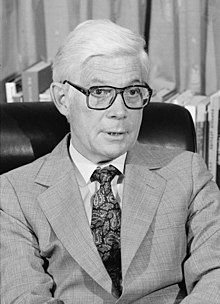
- I didn’t come out of the campaign with the sense that I’d thrown my career away or thrown my life away on what was a fruitless, feckless endeavor. I felt that I had made my mark on the pages of history and laid down some markers for others possibly to follow.
- John B. Anderson, on his 1980 Independent campaign for the U.S. Presidency, as quoted in No Holding Back : The 1980 John B. Anderson Presidential Campaign (2011) by Jim Mason, p. 412
- What do a former senator, a professional wrestler, and a talk-show host have in common? Each was elected governor as an Independent during the last decade of the twentieth century – impressive not just because they won without the support of the local political establishment, but because they ran explicitly in opposition to it. Seen side by side, Connecticut's Lowell Weicker, Minnesota's Jesse Ventura, and Maine's Angus King make a motley crew. Each was a proudly unorthodox politician whose willingness to speak his mind was a primary source of his popularity. Their potent combination of common sense and maverick appeal was well expressed by one young woman. ...
- John Avlon, in Independent Nation: How the Vital Center Is Changing American Politics (2004), "Radical Centrism" section, p. 277.
C
[edit]- For the left, an obsession with the state. For the right, a worship of the market. But as liberals, we place our faith in people. People with power and opportunity in their hands. Our opponents try to divide us with their outdated labels of left and right. But we are not on the left and we are not on the right. We have our own label: Liberal. We are liberals and we own the freehold to the centre ground of British politics. Our politics is the politics of the radical centre. We are governing from the middle, for the middle.
E
[edit]
- My aim is not the establishment of an anarchist society or the total destruction of the state. Here I differ from anarchists. I do not believe that it is possible to destroy the modern state. It is pure imagination to think that some day this power will be overthrown. From a pragmatic standpoint there is no chance of success. Furthermore, I do not believe that anarchist doctrine is the solution to the problem of organization in society and government. I do not think that if anarchism were to succeed we should have a better or more livable society. Hence I am not fighting for the triumph of this doctrine.
On the other hand, it seems to me that an anarchist attitude is the only one that is sufficiently radical in the face of a general statist system.- Jacques Ellul, in The Ethics of Freedom (1973 - 1974), p. 396
H
[edit]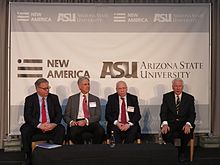
- We call our new political program the Radical Center. We chose this name to differentiate our principles and policies from those of the Democratic Left and the Republican Right. To us, it seems obvious that the familiar varieties of liberalism and conservatism ... are largely irrelevant in the fundamentally different environment of first half of the twenty-first century. "Centrism" itself has become something of a shallow mantra in recent American politics. It is usually involved in a tactical effort to bridge the differences between the existing Left and Right – yielding a "Squishy Center" that lies between Left and Right, rather than a "Radical Center."
- Ted Halstead and Michael Lind, in The Radical Center: The Future of American Politics (2001), pp. 15–16
- We use the word radical – in keeping with its Latin derivation from "radix," or "root" – to emphasize that we are interested not in tinkering at the margin of our inherited public, private, and communal institutions but rather in promoting, when necessary, a wholesale revamping of their component parts.
- Ted Halstead and Michael Lind, in The Radical Center: The Future of American Politics (2001), p. 16
- The underlying purpose of the Radical Centrist program is to further expand America’s perennial goals of individual liberty, equality of opportunity, and national unity in the new circumstances of the Information Age.
- Ted Halstead and Michael Lind, in The Radical Center: The Future of American Politics (2001), p. 16
- In redesigning our nation's public, private, and communal institutions once again for the early twenty-first century, we believe that one design criterion above all others should guide us: increasing the amount of choice available to individual citizens. So far, the information era has enabled most Americans to enjoy newfound choices only as consumers in the economic and entertainment spheres. Any new political program worthy of the Information Age must be capable of translating this so far narrow expansion of choices to many other spheres of society: voting choices, educational choices, medical choices, retirement choices, lifestyle choices, and career choices.
- Ted Halstead and Michael Lind, in The Radical Center: The Future of American Politics (2001), p. 19
- A second guiding principle of Radical Centrism is that the citizens of the twenty-first century can and should be held to a higher personal standard. In this new era of big citizenship, greater choice and freedom must go hand in hand with greater responsibility. Formerly, civic duty was identified primarily with military service, jury duty, and the act of voting. But the definition of civic duty now needs to be expanded, especially in a society in which most citizens receive transfer payments or subsidies from their fellow taxpayers. In such a society, self-reliance must become a civic duty as well as a private virtue.
- Ted Halstead and Michael Lind, in The Radical Center: The Future of American Politics (2001), p. 21
- To criticize the New Deal welfare model that is routinely defended by today's Democratic Party is not to side with today's Republican Party, which has established a troubling record of slashing funds to the neediest and youngest Americans. The Radical Centrist alternative is a true safety net model, under which public benefits would be provided to those who need them the most, while those who can afford to pay their own way would be required to do so.
- Ted Halstead and Michael Lind, in The Radical Center: The Future of American Politics (2001), p. 23
- The phrase "the radical center" was used to describe disaffected white working-class Democrats by the sociologist Donald I Wallace in The Radical Center: Middle Americans and the Politics of Alienation ... . Replying to Joe Klein's Newsweek cover story "Stalking the Radical Middle," September 25, 1995, John Judis distinguished between the political views of the working-class "radical middle" or "radical center," and the affluent "sensible center" ... we are not using the term Radical Center in this narrow sense, which changes in partisanship and demography already may have rendered obsolete. Rather, we use the term to describe a public philosophy distinct from liberalism and conservatism in the forms in which they have been familiar for the past generation.
- Ted Halstead and Michael Lind, in The Radical Center : The Future of American Politics (2002), p. 230
- The author referred to in the first sentence is Donald I. Warren, not "Donald I. Wallace" as stated by the authors in both their original edition from 2001 and the first paperback edition from 2002, which is cited here. A quote from the Warren book can be found elsewhere on this page.
J
[edit]- Virtually all ideologues, of any variety, are fearful and insecure, which is why they are drawn to ideologies that promise prefabricated answers for all circumstances.
- Jane Jacobs, in Dark Age Ahead (2004), Ch. 5 : Dumb-Down Taxes, p. 115
K
[edit]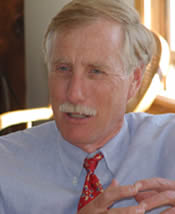
- We proved that with civility, common sense, building bridges, working with coalitions and working with people one at a time, we could do something. … I can speak for the middle. … The real issue is the system itself.
- If you like the system as it is, I’m not your guy… If you want a shot at changing it, join me.
- Angus King, as quoted in "Why Angus King is the most important Senate candidate in the country" by Aaron Blake in The Washington Post (6 March 2012)
- I don't have any illusions it will be easy, but I do think particularly if the two parties are closely divided, I will have an influence … I might have a chance of starting a movement toward change in this broken system. This country has serious problems, but you can't address them if the institution set up to address the problems is broken.
- Angus King, as quoted in "Angus may be a king-maker" by Deborah McDermott in Seacoast Online (11 March 2012)
- We could send down a combination of Pericles and Thomas Jefferson, and if that person's reporting to Harry Reid [Senate Majority Leader] or Mitch McConnell [Senate Minority Leader], he's going to be ineffective. … Every vote is a test vote. Every vote is party loyalty. We're sunk if it keeps up this way. … It wouldn't take but four or five centrists like me to completely change the dynamics.
- Angus King, as quoted in "Angus may be a king-maker" by Deborah McDermott in Seacoast Online (11 March 2012)

- Radicals have value, at least; they can move the center. On a scale of 1 to 5, 3 is moderate, 1 and 5 the hardliners. But if a good radical takes it up to 9, then 5 becomes the new center. I already saw it working in the American Muslim community. For years women were neglected in mosques, denied entrance to the main prayer halls and relegated to poorly maintained balconies and basements. It was only after a handful of Muslim feminists raised "lunatic fringe" demands like mixed-gender prayers with men and women standing together and even women imams giving sermons and leading men in prayer that major organizations such as ISNA and CAIR began to recognize the "moderate" concerns and deal with the issue of women in mosques.
I've taken part in the woman-led prayer movement, both as a writer and as a man who prays behind women, happy to be the extremist who makes moderate reform seem less threatening. Insha'Allah, what's extreme today will not be extreme tomorrow.- Michael Muhammad Knight, in Journey to the End of Islam (2009)

- Philosophically as well as politically, Capek was a man of the center, but not in the sense used by hostile critics. The center he was aiming for was not a lukewarm middle ground between extremes. It was a radical center, radical in the original sense of the word: at the root of things. Capek rejected collectivism of any type, but was just as opposed to selfish individualism. He was a passionate democrat and a pluralist. He was often called a relativist because he disliked single vision and preferred to look at everything from many sides … Yet Capek did not believe that truth is relative nor that everyone his or her own truth. Capek is also often described as a pragmatist. But in his belief in the reality of objective truth, he departed from both relativism and from pragmatist thought.
- Peter Kussi, in his Introduction to Toward the Radical Center: A Karel Čapek Reader (1990), p. 10
L
[edit]
- Do not be deceived by the way men of bad faith misuse words and names … It used to be only the English who excelled in the deception of words. Then the French went even beyond them, and now the whole world is adept at it. … Things are set up as contraries that are not even in the same category. Listen to me: the opposite of radical is superficial, the opposite of liberal is stingy; the opposite of conservative is destructive. Thus I will describe myself as a radical conservative liberal; but certain of the tainted red fish will swear that there can be no such fish as that. Beware of those who use words to mean their opposites. At the same time have pity on them, for usually this trick is their only stock in trade.
- R. A. Lafferty, in The Flame is Green (1971), Ch. 5
M
[edit]- Since 1994, when the Clinton health care plan imploded in a fiasco that cost Democrats control of the Congress, Democrats have been too scared to think big again. Republicans, emboldened by this Democratic timidity, have chosen to push harder for their traditional priorities of cutting taxes and regulations. What's been lost in the dysfunctional debate of the last decade is a commitment to two long-standing American ideals: equal opportunity and a minimally decent life for citizens of a wealthy nation.
- Matthew Miller, in The Two Percent Solution: Fixing America's Problems in Ways Liberals and Conservatives Can Love (2003), p. xi
- What American politics urgently needs ... is not a new left, but a new center. Domestic debate needs to be re-centered around a handful of fundamental goals on which all of us can agree, whether we call ourselves Republicans, Democrats, or Independents.
- Matthew Miller, in The Two Percent Solution: Fixing America's Problems in Ways Liberals and Conservatives Can Love (2003), p. xi
- Yes, there will always be fights over details. But if we first ask, "What does equal opportunity and a decent life in America mean?" can't we agree that anyone who works full-time should be able to provide for his or her family? That every citizen should have basic health coverage? That special efforts should be made to make sure that poor children have good schools? And that average citizens should have some way to have their voices heard amid the din of big political money?
- Matthew Miller, in The Two Percent Solution: Fixing America's Problems in Ways Liberals and Conservatives Can Love (2003), p. xi
R
[edit]- A radical is a man with both feet firmly planted — in the air. A conservative is a man with two perfectly good legs who, however, has never learned to walk forward. A reactionary is a somnambulist walking backwards. A liberal is a man who uses his legs and his hands at the behest — at the command — of his head.
S
[edit]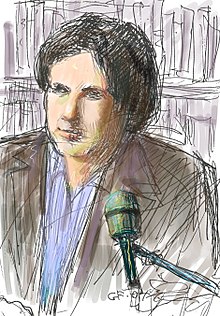
- When we Americans disagree over issues like abortion or gun control, typically we'll "battle it out" until one side "wins." But one side rarely "wins" for long. The losing side always seems to come back with reinforcements, ready for more. For most Americans, this constant balling is the very essence of politics. But more and more of us are beginning to suspect that the batting, itself, is part and parcel of what we need to overcome. ... The idea here is not so much to come up with a better political platform as it is to come up with a better political discourse ... one that forces all "sides" to listen to and learn from each other. Out of this new discourse, a better political platform may emerge.
- Mark Satin, in New Options for America: The Second American Experiment Has Begun (1991), p. 218
- There is a hunger in this country for a new kind of politics. There is a hunger for a politics that can take us beyond the usual venomous blame games in Washington, D.C. There is a hunger for a politics that appreciates the genuine and often very reasonable concerns of the left and right, and builds on them toward something new. There is a hunger for a politics that's idealistic but without illusions, a politics that dares to suggest real solutions to our biggest problems but doesn't lose touch with the often harsh facts on the ground. There is a hunger for a politics that expresses us as we really are – practical and visionary, mature and imaginative, sensible and creative, all at once.
- Mark Satin, in Radical Middle: The Politics We Need Now (2004), p. ix
- Our politics today doesn't express either our practical, grounded side or our visionary, creative side. It is all about the short term, not the long term. It is all about blaming others for our problems, not about turning our problems into opportunities by addressing them in the forthright, imaginative ways you know we can.
- Mark Satin, in Radical Middle: The Politics We Need Now (2004), pp. ix–x
- More than two centuries ago, Benjamin Franklin wanted us to invent a uniquely American politics that served ordinary people by creatively borrowing from all points of view. It's not too late for us to listen to him.
- Mark Satin, in Radical Middle: The Politics We Need Now (2004), p. x
- Many nonpartisan or post-partisan Americans are asking basic questions, now, that can move us toward a new and more relevant politics. Here are four I've put front and center in this book:
- How can we give ourselves more choices in life?
- How can we give everyone a fair start in life?
- How can we maximize our potential as human beings?
- How can we be of use to the developing world?
- Mark Satin, in Radical Middle: The Politics We Need Now (2004), pp. x–xi
- At the radical middle, we're ... proposing concrete answers – practical solutions to the most pressing issues of our time. For example, with just a little bit of cleverness and imagination, and a willingness to borrow, humbly, from neoliberals, neopopulists, neoconservatives, and transformationalists alike, we can make ourselves energy independent within 10 years. We can create a universal health care system that's preventive, and affordable, and not government-run. We can provide affirmative action for all economically disadvantaged Americans. We can create corporations we'd actually enjoy working for. We can make globalization work for everyone. We can keep terrorists away from our shores – and at the same time come to passionate grip with the causes of terrorism. I've woven all these ideas and more into this book. ...
- Mark Satin, in Radical Middle: The Politics We Need Now (2004), p. xi
T
[edit]- At a time when politics has become an almost minute-by-minute spectacle, political thinkers who try to discern a sweeping interpretive pattern in current events or to predict where those events may be heading are likely to find their work evaluated in terms dismayingly like those applied to candidates and strategists. One wrong guess, or an abrupt change in the political weather, can make even an illuminating political book seem as irrelevant as a bungled campaign.
A good example is Ted Halstead and Michael Lind’s book The Radical Center: The Future of American Politics. Published in 2001, it argued that the nation was ready for “political transformations and realignments” as broad in scope as those created by the Civil War and the Great Depression. … if Halstead and Lind’s proposals were questionable, their analysis of the paralyzed condition of American governance was incisive and prescient, particularly their depiction of a substantial base of disenchanted voters who had become profoundly alienated from the “increasingly dogmatic two-party system,” both parties “captured by their extremes,” with the result that a growing slice of the electorate could not “find even a faction within a major party with which they can identify.”- Sam Tanenhaus, in "The Radical Center: The History of an Idea", in The New York Times (14 April 2010)
- When The Radical Center was published, mere weeks after the trauma of 9/11, its picture of a highly polarized nation seemed instantly outmoded. … Not quite a decade later, things look very different. “Big government” is once again viewed with deep hostility, and much of the public is not merely cynical, but fuming. Many on the left feel betrayed by the Obama administration and Congressional Democrats, while the Tea Party movement has been expressing the same “radical” frustrations Halstead and Lind described. Meanwhile, political observers are recycling, if not always wittingly, the authors’ terminology. In his Times Op-Ed column, Thomas L. Friedman recently called for “political innovation that takes America’s disempowered radical center and enables it to act in proportion to its true size, unconstrained by the two parties, interest groups and orthodoxies that have tied our politics in knots.” And David Ignatius, the Washington Post columnist, has said that officials at Barack Obama’s White House “speak of this president as being a man of the radical center” who seeks to occupy the ideological middle but at the same time aspires to “be the agent of change, to break this system that everybody knows is broken.”
- Sam Tanenhaus, in "The Radical Center: The History of an Idea", in The New York Times (14 April 2010)
- Halstead and Lind drew explicitly on “The Radical Center: Middle Americans and the Politics of Alienation,” a sociological study published in 1976. Its author, Donald I. Warren, had supervised nearly 2,000 interviews with a cross-section of citizens, almost all of them white, in an effort to isolate the attitudes of “middle American radicals,” whose anger at political and social institutions had erupted in the early and mid-1970s. … Put roughly, “radicals” were blue-collar Catholics, and “average middles” were white-collar Protestants.
The novelty of Halstead and Lind’s book lay in its suggestion that subsequent changes in demographics and party affiliation had collapsed the two warring factions into one. Between 1970 and 2000, the percentage of college graduates in the population at large had more than doubled, from one in 10 to one in four. Evangelicals had joined Catholics among the ranks of social conservatives. The working-class “flight” from the Democratic Party was all but completed in the 1980s and ’90s even as moderate Republicans began to vote for Democrats.
The question Halstead and Lind tried to answer, whether this fusion of the two “middles” might form a new consensus, is again the most pressing issue of the day, with conflicting answers supplied by left and right, and with the outcome fluctuating from moment to moment, possibly confirming the authors’ guess that “the future of American politics may well belong to the major party that is first to renounce its more extreme positions.” This is why “The Radical Center” remains valuable even as the political realities that seemed to discredit its argument a decade ago have themselves proved fleeting.- Sam Tanenhaus, in "The Radical Center: The History of an Idea", in The New York Times (14 April 2010)
V
[edit]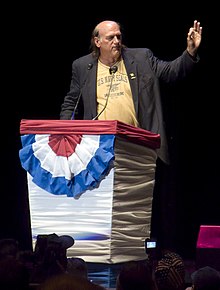
- I am not a career politician. I'm not a Democrat. I'm not a Republican. I'm a working man with commonsense ideas and goals. I describe myself politically as fiscally conservative and socially moderate-to-liberal.
- Jesse Ventura, in I Ain't Got Time To Bleed: Reworking the Body Politic from the Bottom Up (1999)
- I view the traditional two parties as in some ways very evil. They've become monsters that are out of control. … The only things that are important to them are their own agendas and their pork. Government's become just a battle of power between the two parties.
- Jesse Ventura, in I Ain't Got Time To Bleed: Reworking the Body Politic from the Bottom Up (1999)
- I'd like to work on having every fourth year become a year in which no laws are made, but the old laws are reviewed, updated, or deleted as needed. That way we won't get endless, obsolete laws piling up on the books.
- Jesse Ventura, in I Ain't Got Time To Bleed: Reworking the Body Politic from the Bottom Up (1999)
W
[edit]- There is a distinct force in American society which is both volatile and pivotal in its activism ... - the Middle American Radical (MAR). Their perspective does not fit readily the traditional molds of liberal and conservative ideologies. ... On some issues, MARs are likely to take a "liberal" stand, on others a "conservative" one. For example, the MAR expresses a desire for more police power. He feels that granting the police a heavier hand will help control crime, i.e., [Alabama Governor George] Wallace's Law and Order program. However, MARs are also adamant about keeping many social reforms, often wrought by the left, such as medicare, aid to education, and social security. Often MARs feel their problems stem from the rich and the government working together to defraud the rest of the country. They blame the situation on defects in the system such as bad taxes. However, their causal analysis does not suggest what effective remedial actions they can pursue as individuals.
- Donald I. Warren, in The Radical Center: Middle Americans and the Politics of Alienation (1976), p. 1
See also
[edit]Further reading
[edit]- Renata Adler, Toward a Radical Middle: Fourteen Pieces of Reporting and Criticism (1969).
- Denis Beckett, Radical Middle: Confessions of an Accidental Revolutionary (2010). Published in South Africa.
- Nick Clegg, "The Liberal Moment" (2009). Booklet from the UK's Demos think tank.
- Joe Klein, "Stalking the Radical Middle". Newsweek (24 September 1995), pp. 32–36. The reprint omits Klein's byline.
- Robert L. Olson, "The Rise of 'Radical Middle' Politics". The Futurist (January–February 2005), pp. 45–47. Publication of the World Future Society.
- Noel Pearson, Up From the Mission: Selected Writings, 2nd ed. (2011), "The Quest for a Radical Centre" section. Published in Australia.
External links
[edit]- Fifty Thinkers and Activists (Try to) Describe the Radical Middle. Book and article excerpts spanning 1969–2009, collected by Mark Satin for his Radical Middle Newsletter.
- New America Policy Papers. Ongoing series of position papers from the New America Foundation, co-founded by Ted Halstead and Michael Lind to bring radical centrism to Washington, D.C. See Reference #1 above.


